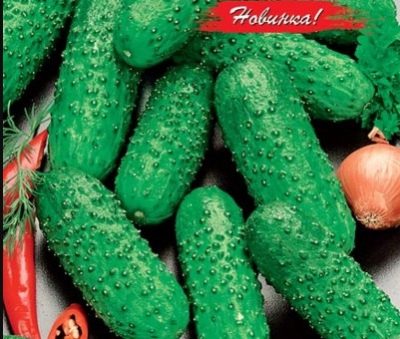
- Authors: Maksimov Sergey Vasilievich, Klimenko Nikolay Nikolaevich, Chistyakova Lyubov Aleksandrovna (LLC "Agrofirma" Poisk "")
- Year of approval: 2015
- Growth type: indeterminate
- Branching: the average
- Fruit weight, g: 110-130
- Fruit length, cm: 10-12
- Fruit color: dark green with medium stripes
- Cucumber Mosaic Virus Resistance: stable
- Ripening terms: early
- Fruit shape: cylindrical
Fast and Furious is a salad cucumber subspecies developed by domestic experts and approved for use in 2015. For six years, the properties of the presented variety have been well studied, so every gardener can immediately determine whether he is ready to grow Fast and Furious cucumbers.
Description of the variety
This hybrid belongs to the parthenocarpic species, that is, it does not need pollination. It is allowed to grow a plant under a temporary film cover or in a film greenhouse. It is a high-yielding variety with a pleasant taste.
Characteristics of the appearance of plants and zelents
The bush is of an indeterminate type, that is, its growth is not limited by anything, it has medium branching and dark green leaves. 2-3 female flowers are formed in one node. Zelentsy are cylindrical in shape, have large tubercles and white thorns, short, only 10-12 cm in length. The diameter is 3-4 cm.The weight of the fruit is 110-130 g.
Purpose and taste of fruits
The fruit has a good taste and a pleasant fresh aroma. Zelentsy can be used for pickling and canning, and are also used for fresh consumption, and the taste is best revealed in a light vitamin salad. Among the advantages, it is worth noting milk seeds, which are practically not felt when consumed.
Maturation
This is an early variety that forms the first fruits 38-42 days after sprouting.
Yield
The variety belongs to high-yielding varieties of culture: from one square meter, it is possible to collect an average of 12.5 kg of fruits.
Landing scheme
Seeds are sown in April or May, and seedlings are planted in the greenhouse from May 25 to June 5. At this time, the soil is already warmed up to +10 degrees, so young shoots will feel comfortable. More specific terms depend on the climatic conditions in which the crop is grown. When caring for seedlings, it is important to maintain a temperature of + 22-25 degrees. Daylight hours should be up to 16 hours; for this, gardeners use phytolamps.
7-10 days before transplanting, the shoots should be hardened, that is, they should be taken out into fresh air, daily increasing the time they spend outside. By the day the sprouts are planted, there should already be 3-4 real leaves on them. It is recommended to plant the culture of the presented variety at a distance of 30-40 cm between the bushes, and a distance of 70 cm is left between the rows.
Growing and care
The afterburner has a powerful root system that is capable of absorbing nutrients well from any type of soil, so the variety grows well even in saline soils. But if this vegetable is picky about the type of soil, then non-observance of other rules of agricultural technology can adversely affect its health.
The plant must be tied to a trellis, form it into one stem. In the first three nodes, eliminate all shoots and ovaries, then leave the ovaries, but continue to remove the lateral shoots. This variety is very responsive to watering. Moisten the bed with warm, settled water.The culture responds well to drip irrigation. For 1 square meter, use 6-12 liters of water.
It is also important to regularly loosen and weed the soil so that the earth does not become crusty and continues to allow moisture and nutrients to pass through. Do not forget about mulching the soil with a layer of 10 cm. Fertilizer is applied 3-4 times during the growing season, use complex formulations for feeding.

In order to collect strong, tasty and beautiful cucumbers on your site, you need to make top dressing. Lack of nutrients can negatively affect the appearance of the plant and significantly reduce the yield. Fertilize cucumbers with organic fertilizers in combination with mineral fertilizers. With the right balance of these components and adherence to the fertilizing schedule, the cucumber yield will be maximum.
Disease and pest resistance
The cucumber variety has a very high immunity to common diseases: mosaic, cladosporium disease, powdery mildew. It tolerates adverse weather well, but can fall prey to the following pests.
- Aphid. Treating these pests with infusions of dandelions, garlic or celandine, tobacco or mustard powder, as well as solutions of vinegar or hydrogen peroxide. The most effective artificial drugs are Fitoverm, Iskra, Aktara.
- Whitefly. You can get rid of this individual by freezing the greenhouse. Another way is the use of insecticides "Tanrek", "Inta-Vir", "Iskra".
- Thrips. In this case, decoctions of celandine or garlic will help, and in advanced cases, use "Aktara" or "Inta-Vir".
So that small insects, especially thrips, do not fly into the greenhouse, put fine-mesh nets on the windows, keep the summer cottage clean, plant marigolds and yarrow next to the greenhouse: these plants scare off pests with their smell.

Despite their popularity, cucumbers are often attacked by diseases and pests. From them, cucumber plantings often die before the start of fruiting. In order to prevent this from happening, it is necessary to try to prevent ailments or get rid of them at the very beginning, having studied in detail their causes of occurrence, signs and methods of treatment.





























































































